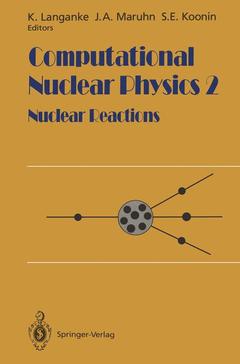Computational Nuclear Physics 2, Softcover reprint of the original 1st ed. 1993 Nuclear Reactions
Langue : Anglais
Coordonnateurs : Langanke K., Maruhn J.A., Koonin S.E.

Computation is essential to our modern understanding of nuclear systems. Although simple analytical models might guide our intuition, the complex ity of the nuclear many-body problem and the ever-increasing precision of experimental results require large-scale numerical studies for a quantitative understanding. Despite their importance, many nuclear physics computations remain something of a black art. A practicing nuclear physicist might be familiar with one or another type of computation, but there is no way to systemati cally acquire broad experience. Although computational methods and results are often presented in the literature, it is often difficult to obtain the working codes. More often than not, particular numerical expertise resides in one or a few individuals, who must be contacted informally to generate results; this option becomes unavailable when these individuals leave the field. And while the teaching of modern nuclear physics can benefit enormously from realistic computer simulations, there has been no source for much of the important material. The present volume, the second of two, is an experiment aimed at address ing some of these problems. We have asked recognized experts in various aspects of computational nuclear physics to codify their expertise in indi vidual chapters. Each chapter takes the form of a brief description of the relevant physics (with appropriate references to the literature), followed by a discussion of the numerical methods used and their embodiment in a FOR TRAN code. The chapters also contain sample input and test runs, as well as suggestions for further exploration.
1. One-Boson-Exchange Potentials and Nucleon-Nucleon Scattering.- 1.1 The Meson Theory of Nuclear Forces.- 1.2 Relativistic Two-Nucleon Scattering.- 1.3 One-Boson-Exchange Potentials.- 1.4 Numerics and Codes.- 1.5 Using the Codes.- 1.6 What Else?.- Acknowledgments.- References.- 2. The G-Matrix in Finite Nuclei.- 2.1 Introduction.- 2.2 The G-Matrix, a First Step Towards an Effective NN Interaction.- 2.3 The Solution of the Bethe-Goldstone Equation.- 2.4 Details of the Numerical Calculation.- 2.5 Some Examples for Tests and Studies.- 2.6 Technical Note.- References.- 3. The Nuclear-Matter Effective Interaction.- 3.1 Background.- 3.2 The Bethe-Goldstone Equation in Uniform Matter.- 3.3 The Reference Spectrum Method.- 3.4 The Legindgaard Representation.- 3.5 Numerical Methods.- 3.6 Remarks on the Code.- 3.7 Performance.- 3.8 Things to Do.- References.- 4. Microscopic Description of Nuclear Collisions.- 4.1 Introduction.- 4.2 Theoretical Background to the Resonating Group Method.- 4.3 A Short Description of the Numerical Methods Used and the Program Structure.- 4.4 Installation and Use of the Codes.- 4.5 Physical Applications.- 4.6 Technical Note.- References.- 5. The Distorted-Wave Born Approximation.- 5.1 General Description of DWUCK4.- 5.2 Specific Cases of Reactions.- 5.3 Description of the Input for DWUCK4.- 5.4 Sample Cases-Input and Output.- 5.5 Things to Do.- 5.6 Technical Note.- References.- 6. Statistical-Model Calculations with Angular-Momentum Coupling.- 6.1 Background.- 6.2 Basic Features of the Code.- 6.3 Level-Density Tables.- 6.4 Transmission Coefficients.- 6.5 Fission Barrier and Probability.- 6.6 Angular Distribution.- 6.7 Special Programming Features.- 6.8 Input and Output Files.- 6.9 Summary.- 6.10 Technical Note.- References.- 7. The Time-Dependent Hartree-Fock Approximation for Nuclear Slabs.- 7.1 Background.- 7.2 Interaction.- 7.3 Reduction to One Dimension.- 7.4 Numerical Methods.- 7.5 Remarks on the Code.- 7.6 Running the Code.- 7.7 Things to Do.- References.- 8. The Vlasov-Uehling-Uhlenbeck Model.- 8.1 Introduction.- 8.2 Theoretical Description of Heavy-Ion Collisions.- 8.3 The VUU Equation.- 8.4 The Nuclear Equation of State.- 8.5 Numerical Realization.- 8.6 The Basic Structure of the Program.- 8.7 Running the Program.- 8.8 Input Examples.- 8.9 Interpretation of the Output.- 8.10 Output Analysis with VUUANL.- 8.11 Final Comments on Using the Program.- 8.12 Test Output.- References.- 9. The Friction Model for Deep-Inelastic and Fusion Reactions.- 9.1 Introduction.- 9.2 Description of the Program.- 9.3 The Structure of the Final Printout File.- 9.4 Running the Code with the Sample Input.- References.- 10. The Quark Model and the Nucleon-Nucleon Interaction.- 10.1 Introduction.- 10.2 The Resonating Group Method.- 10.3 The Hamiltonian of the Six-Quark System.- 10.4 Remarks on the Code.- 10.5 Technical Note.- References.- 11. Hadron-Hadron and Hadron-Nucleus Scattering.- 11.1 Introduction.- 11.2 Multiple Scattering Off Nuclei.- 11.3 Hadronic Interactions in the Quark Model.- 11.4 Conclusion.- 11.5 Technical Note.- References.
Date de parution : 04-1993
Date de parution : 10-2011
Ouvrage de 203 p.
15.5x23.5 cm
Thème de Computational Nuclear Physics 2 :
Mots-clés :
Potential; fission; fusion; hadron; nuclear model; nuclear physics; nuclear reaction; nucleon; numerical method; numerics; quark; scattering
© 2024 LAVOISIER S.A.S.
